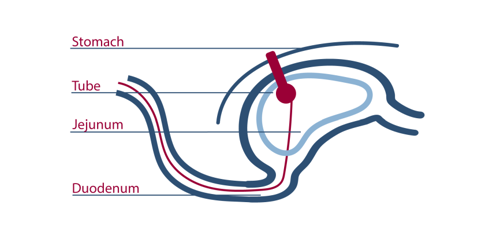Percutaneous radiologic gastrostomy (PRG)
What is a percutaneous radiologic gastrostomy?
Percutaneous radiologic gastronomy is a procedure in which a feeding time is placed into the stomach for feeding. This is necessary for patients who cannot eat enough by themselves. If a feeding tube cannot be inserted through the esophagus, a percutaneous radiologic gastrostomy (PRG) may be an option. Percutaneous gastrostomy is a method of placing a feeding tube into the stomach through the abdominal wall using imaging. The tube is kept in the right position using a balloon and is suitable for long-term use.

Illustration percutaneous radiologic gastrostomy (PRG)
 nl
nl
 Nederlands (Nederland)
Nederlands (Nederland)
 English (United States)
English (United States)